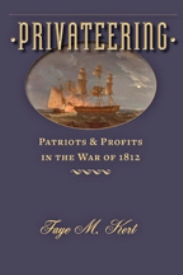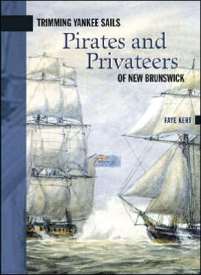 Pirates and Privateers Pirates and Privateers
The History of Maritime
Piracy
Cindy Vallar, Editor
& Reviewer
P.O. Box 425,
Keller, TX 76244-0425
    
Books for Adults ~ History:
Privateering
Privateering (Cindy's
review) (Irwin's review)
Trimming Yankee
Sails

Privateering: Patriots &
Profits in the War of 1812
by Faye M. Kert
Johns Hopkins University, 2015, ISBN 978-1-4214-1747-9,
US $55.00
    
With its
origins in the Middle Ages, governments considered
privateering a legitimate weapon in their war
arsenal and maritime law reinforced that belief.
Once the United States declared war on 18 June 1812,
men and ships set sail to hunt British merchant
shipping. These American privateers captured almost
500 prizes during the first six months of the war,
but British colonial privateers couldn’t retaliate
until after Britain declared war four months later
on 13 October. In Dr. Kert’s latest study of
privateering during the War of 1812, she examines
the role they played, a field of study rarely
focused on in books about the conflict. One reason
for this stems from the difficulty of tracking down
the necessary data in the historical record because
it’s not collected in just a few archives. Privateering
is her attempt at pulling together details from
the widely scattered historical resources into a
single volume to shed light on these privateers,
both the vessels and the men aboard them.
In her introduction she provides an overview on the
war, the necessary requirements for privateers to
operate, and maritime trade, both in the United
States and Canada. It provides not only the
background for subsequent chapters but also insight
into the source material she uses for her data,
together with the difficulties encountered in
compiling the information. She makes clear how both
sides underestimate how long the war will last and
how Royal Navy tactics eventually force American
privateers to seek their prey farther and farther
from their home ports.
The first chapter, “In Flagrante Bello,” covers
items in a privateer’s arsenal, the war and how
citizens view it, public and navy attitudes toward
these privately armed vessels, their crews, the cost
to the public and the merchant marine, the impact of
the British blockade of American seaports, and the
use of convoys to protect merchant shipping and the
problems inherent in them. Kert also compares
American and British colonial (Canadian) privateers.
Chapter 2, entitled “‘True, Publick and Notorious’,”
explains the difference between letter-of-marque
vessels and privateers. The legal aspects of
privateering and prize law, its origins, neutrality
and international law, and admiralty court processes
are also discussed.
The cost of war and the effects of commercial
warfare, as well as differences between licensed
trade, smuggling, and the business of privateering
are examined in Chapter 3, “No Prey, No Pay.” Aside
from the men who sail aboard privateers, Kert looks
at how privateering provides employment in other
trades. She compares ships sailing for both sides,
Atlantic Canada and the United States.
The next chapter, “The Misfortunes of War,” explores
the dangers of investing in privateers and the risks
privateersmen take when working on these vessels.
Some perils are specifically related to the war,
while others are those all mariners face. Specific
captains – Joshua Barney, George Coggeshall, George
Crowninshield, Thomas Boyle, and Samuel C. Reid –
are also considered.
“The Prizewinners,” the final chapter, summarizes
the careers of some of the most successful
privateers. The Canadians include Liverpool
Packet out of Liverpool, Nova Scotia, and Retaliation
and Sir John Sherbrooke out of Halifax, Nova
Scotia. The Americans are Yankee (Bristol,
Rhode Island), Comet and Surprise (Baltimore,
Maryland), America (Salem, Massachusetts),
Saucy Jack (Charleston, South Carolina), Fox
(Portsmouth, New Hampshire), and General
Armstrong (New York, New York). One additional
privateer is also included, True Blooded Yankee,
which is American owned, but sails out of France.
Three captains are also highlighted: Joseph Barrs,
Jr. (Canada), Thomas Boyle (USA), and Samuel C.
Reid, whose American vessel is attacked by the Royal
Navy in a neutral port.
Aside from the Conclusion, which summarizes what her
research shows, Kert includes the appendix “Prize
Makers and Prizes.” There is also an essay of
sources, as well as chapter notes and an index. The
narrative is enhanced with black-&-white maps,
reproductions of related documents, pictures, and
tables.
Privateering during the War of 1812 is Dr. Kert’s
specialty and this volume is a welcome and
much-needed addition to the body of knowledge
published on this conflict. The depth of her
research is evident in her well-written and
fascinating account of the privateers and what they
face when they sail from home. Her comparison
between the two sides provides a dynamic and
well-rounded picture of privately armed vessels and
their contributions to the war. Privateering is
an essential resource for any collection whose focus
is on American, Canadian, and British history and
maritime history. It is also an excellent book for
any lay reader seeking a clear understanding of
privateers and the role they play during the War of
1812.
Review
Copyright ©2016 Cindy Vallar


Privateering: Patriots &
Profits in the War of 1812
by Faye M. Kert
Johns Hopkins University, 2015, ISBN
978-1-4214-1747-9, US $55.00
    
review by Irwin Bryan
This is an excellent
book on the business of
privateering during the War of
1812. The text is very informative
and well written. Supported by a
number of footnotes, which are
easy to locate after the
narrative, it is clear that this
material has been thoroughly
researched and includes facts that
are not presented elsewhere.
The
opening chapter provides an
overview of privateering during
the war. This covers the reasons
it benefited the American war
effort; the American and
Canadian owners and
privateersmen involved; the
extent to which it was
prosecuted against the enemy;
the impact these
merchant-ships-turned-warships
had on the British economy; and
the efforts of the Royal Navy to
combat this menace.
Unlike
most authors on privateering who
provide an obligatory history in
a few introductory pages, Dr.
Kert provides an entire chapter
that traces the early
development of privateering, the
creations of and refinements in
prize law, and the separate
establishment of admiralty and
prize courts in Great Britain
and the United States.
Next,
we read how, in the years
leading up to the war, American
vessels were licensed by the
British to carry supplies for
their country and armies
fighting the French in Spain.
Others were engaged in the
smuggling trade, supplying
French, British, and even
American citizens with duty-free
and hard-to-obtain goods. All of
these activities ended or
declined with the declaration of
war.
Conversely,
building or fitting-out merchant
ships as privateers and manning
them for a voyage created new
business and opportunities for
everyone connected to the
maritime industry. The hopes of
obtaining prizes of valuable
ships and cargoes motivated all.
But only if a prize made it back
to a friendly port was there a
chance for that to occur. The
convoy system made taking a
prize difficult and an
increasingly tighter blockade by
the Royal Navy made sending out
privateers and the safe return
of prizes almost impossible.
From a cabin boy to an
entrepreneurial shipowner, the
business was “No prey, no pay!”
There
is information on the
misfortunes of war a privateer
may encounter. The dangers of
wind and sea, shipboard
accidents, and confrontations
with an enemy vessel are all
risks the ships and crews face.
Interesting anecdotes of
occurrences on vessels, such as
a lightning strike on Saucy
Jack that kills two men
and wounds four, or the way
three men are injured during a
training session aboard Perry
serve to illustrate the
various dangers.
In
a chapter on “Prizewinners,”
each vessel discussed makes at
least forty captures with at
least half of the captures
making it into a port for
adjudication. These include both
American and Canadian
privateers. With names of Liverpool
Packet, Yankee, Comet,
and Retaliation, their
individual stories are presented
to the reader in an enjoyable
fashion.
As
is fitting for a book on the
business side of privateering,
the author concludes with “The
Final Tally.” A summary of the
value of prizes taken, merchant
vessels lost, and intangible
values gained helps explain why
the subject has had such a
long-lasting interest.
Anyone
interested in knowing why there
was privateering would do well
to read this book. I found it to
be an excellent and appropriate
addition to Johns Hopkins’ books
on the War of 1812.
Review
Copyright ©2016 Irwin Bryan


Trimming
Yankee Sails: Pirates and
Privateers of New
Brunswick
by Faye Kert
Goose Lane Editions, 2005,
ISBN 0-86492-442-9, US
$12.95 / CAN $14.95
    
Volume six of the New
Brunswick Military
Heritage series examines
the Canadian privateers
of the War of 1812. This
maritime port plays an
important role in
19th-century history,
and the information here
covers “[m]istaken
identity, collaborating
with the enemy, false
colours, phony captures,
smuggling, blockade
running and profitable
prize making." This was
the only war in which
New Brunswick plays an
active role in
privateering. Although
the United States
declars war in June
1812, Britain doesn’t do
so until mid-October.
This presents problems
for the seamen and
fishermen on both sides
of the border since New
England trades a lot
with Canada.
Chapter one deals with
New Brunswick during
1812, prior to Britain’s
declaration of war.
Chapter two examines the
privateering ventures
during the next two
years, with particular
emphasis on Dart (their
best-known privateer),
because that vessel’s
log still exists, and
Caleb Seeley, the town’s
most successful
privateer captain.
Chapter three covers the
Chesapeake Affair,
during the American
Civil War.
This is a much needed
resource, for few books
cover Canadian
privateering, especially
during the War of 1812.
The glossary and index
make the information
easily understood and
accessible. The pictures
help to clarify points
in the text or identify
who’s who. The inclusion
of the chapter on
Confederate
privateers/pirates is of
particular interest
since this topic is
rarely covered. This
book serves as a
comprehensive
introduction to a
particular place’s
maritime history where
privateering plays a
vital role in
maintaining commerce
during war time.
Review
Copyright ©2006
Cindy Vallar


Click to contact me
Background image compliments
of Anke's Graphics |


